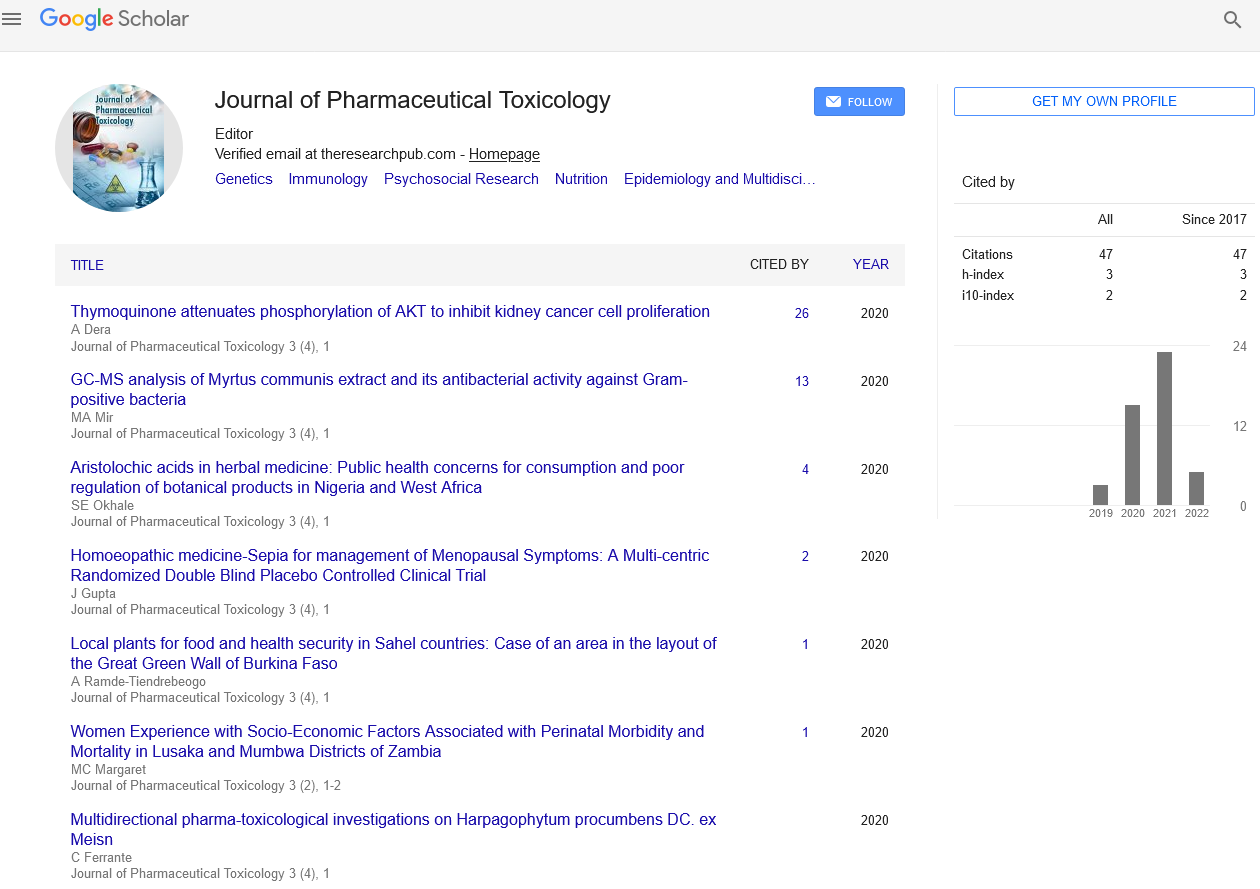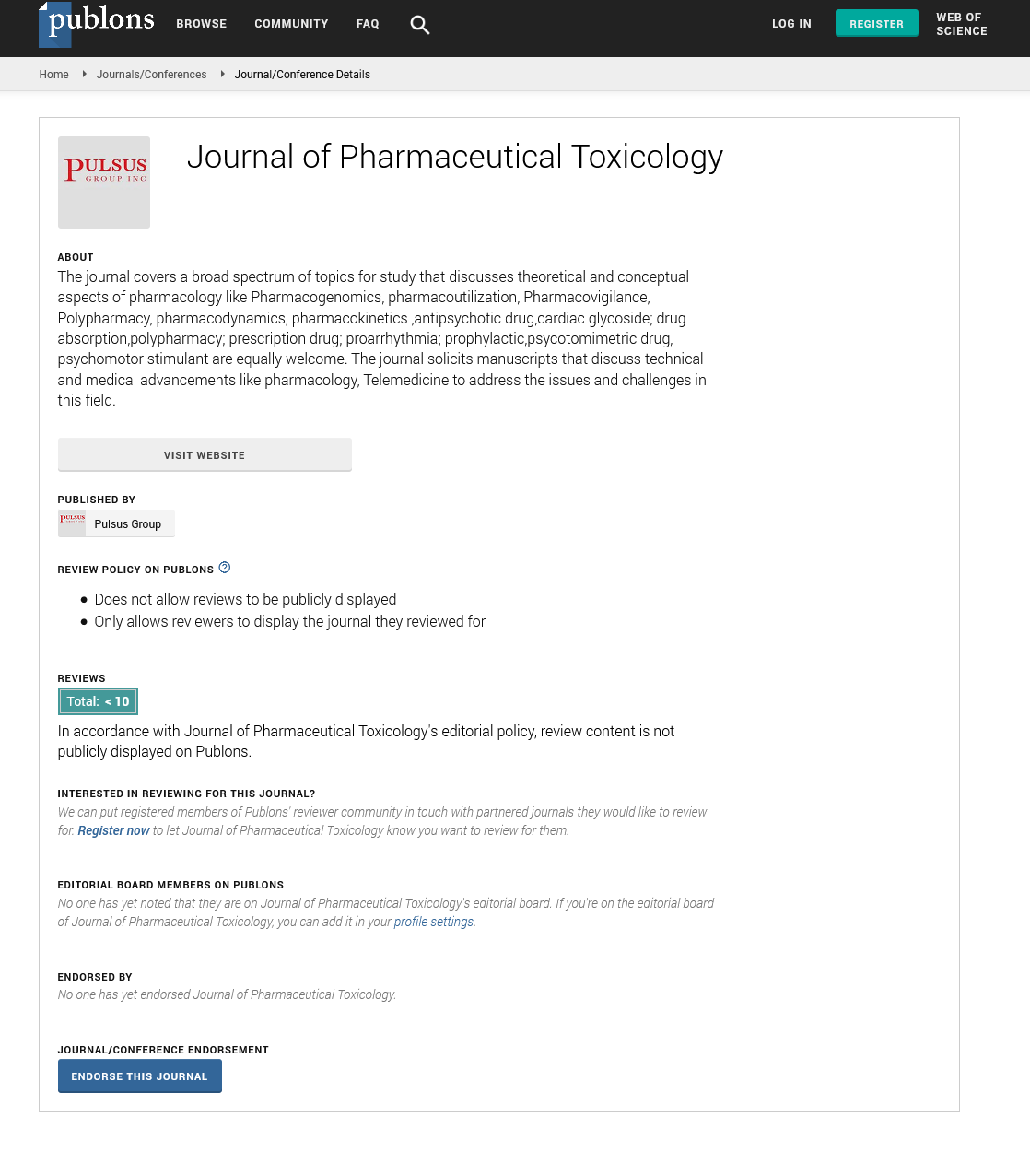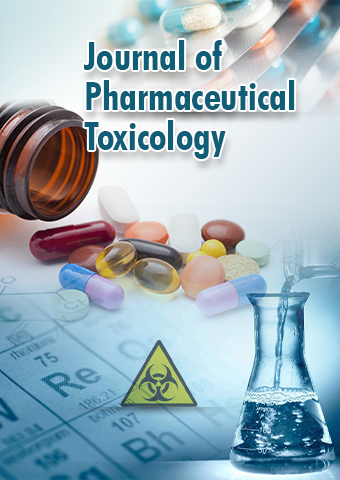Mini Review - Journal of Pharmaceutical Toxicology (2022) Volume 5, Issue 5
Enantiomeric Separation and Determination of the Enantiomeric Impurity of Armodafinil
Ashley Kimberley*
Israeli Medical Corps, Israel Defense Forces, Israel.
Received: 01-Aug-2022, Manuscript No: jpt-22-72494; Editor assigned: 04-Aug-2022, PreQC No: jpt-22- 72494 (PQ); Reviewed: 18-Aug-2022, QC No: jpt-22-72494; Revised: 22- Aug-2022, Manuscript No. jpt-22- 72494 (R); Published: 30-Aug-2022, DOI: 10.37532/jpt.2022.5(5).70-73
Abstract
In recent years, capillary electrophoresis (CE) has been widely used for enantiomer separation and enantiomer impurity determination because of its high efficiency, rapid analysis and low cost of operation. Enantioresolution for CE is typically achieved by adding chiral selectors to the buffer. Versatile native and modified cyclodextrins (CDs) are one among the most commonly used chiral selectors for the inclusion of solute hydrophobic portions by the cavity of CDs and the weak interactions of enantiomers with CDs (such as hydrophobic interactions, hydrogen bonding and van der Waals force, etc.) resulting in differences in stability constants of temporary diastereomeric complexes. Besides, the differences in hydrodynamic resistance arising from the differences in shape, size or hydrodynamic radii, etc.Keywords
Capillary electrophoresis • Armodafinil • Enantiomeric impurity • Sulfobutyl ether-β-cyclodextrin
Introduction
Modafinil is an analeptic drug for the treatment of excessive sleepiness caused by narcolepsy, shift work disorder and obstructive sleep apnea. Compared with other stimulants, it’s a low potential risk of dependence and tolerance, and few serious side effects also. Modafinil may be a chiral compound due to the presence of asymmetric sulfoxide function, but it’s administrated as a racemic mixture of its (R)- and (S)-enantiomers. Both enantiomers are pharmacologically active; however, pharmacological studies showed that the 2 enantiomers differ in their pharmacological properties [1]. The (R)-enantiomer, also referred to as armodafinil (R)-(diphenylmethyl)-sulfonic] acetamide, is reported to features a longer half-life than the (S)-enantiomer and the proportion of circulating (R)-modafinil has been found to be as much as 3-fold that of circulating (S)- modafinil. Due the many pharmacokinetic difference between the two enantiomers, armodafinil was produced by the drug company Cephalonia Inc. and approved by the FDA in 2007 for the treatment of narcolepsy and shift work disorder, and as an adjunctive treatment for obstructive apnea [2, 4]. Furthermore, it’s undergone clinical trials evaluating it as a treatment for serious medical conditions such as bipolar depression and fatigue in conditions such as Parkinson’s disease and cancer. Consistent with the ICH guidance entitled “Specifications: Test procedures and acceptance criteria for new drug substances and new drug products: Chemical substances”, for chiral drug substances which are developed as one enantiomer, control of the opposite enantiomer should be considered in the same manner as for other impurities [5]. Therefore, it’s important to establish an enantiomeric separation and determination method for the control of enantiomeric impurity of armodafinil [6]. Finally, we examined the expression level of Hand2 and Gata5, which are required for cardiogenic differentiation. Interestingly, our real-time PCR results revealed that Hand2 and Gata5 were down regulated in zebra fish embryos injected with FABP3-MO compared to Wt-MO, particularly at 48 hpf, when the expression level of cardiogenic differentiation key gene were significantly decreased in FABP3-MO injected zebra fish and Gata5 was decreased in FABP3-MO injected zebra fish at 72 hpf [7, 8]. Thus, knockdown of FABP3 not only induces significant toxic effects on cardiac development but these effects are also associated with down regulated expression of Gata5, which interact to induce Hand2 expression, which influence looping of the developing heart. This data indicates that FABP3 may be an upstream regulator of important heart genes Gata5 and Hand2 involved, in looping of the heart in zebra fish embryos [9].
Results
The effects of modifier type and concentration on enantiomer solution were studied. Three organic additives methanol, acetonitrile and isopropanol were each added to the BGE to seek out the optimal one. The comparative results indicated that methanol is that the most effective one considering the peak shapes and the resolution of enantiomers. Subsequently, the consequences of methanol concentration on resolution were studied by varying the percentage from 10% to 40% (v/v). The result indicates that an optimal resolution was obtained when 20% methanol added to the BGE. This reason could be that the improvement of BGE viscosity along with the increase of methanol concentration results in a longer migration time and longer interaction time of SBE7-ï¢-CD with the enantiomers, and thus, the resolution was observed to urge better when methanol ascended from 10% to 20% [10]. However, higher concentrations of methanol (20–40%) could be unfavorable for the inclusion of CDs and analytes, and accordingly, cause poorer resolution. After establishing that our FABP3-MO led to knockdown of FABP3 in zebra fish embryos, we performed a systematic investigation of zebra fish heart development. We found that injection of FABP3-MO substantially increased the rate of embryonic lethality in a dose-dependent manner. Based on these preliminary studies, a dose of 5.0 ng of FABP3-MO was chosen to study the effect of FABP3 knockdown in heart development [11]. To minimize off-target effects and strengthen the impact of the observed heart phenotype, we designed the splice-Morpholino of FABP3 (FABP3-MO2) and observed the heart phenotype. At a dose of 5.0 ng MO, we found embryonic or larvae malformations, developmental delay, smaller heads, abnormal eye development, pericardial edema and a linear heart tube phenotype in FABP3-MO injected zebra fish. We interpreted these results to indicate that FABP3 can influence the development of zebra fish, especially with regard to the heart. In addition to the important heart genes, we were also interested in examining other signaling pathways that are known to be important in heart development. In this regard, it is known that multiple signaling pathways converge to regulate heart development, including RA, Wnt, BMP, and Hh signaling. In this study, we focused on the RA signaling pathway in FABP3- MO injected zebra fish. Our results indicated that the RA-metabolizing enzyme, Cyp26a1 was up regulated in FABP3-MO injected embryos, though there was no significant effect on the expression of Raldh2, which synthesizes RA. It is known that RA can regulate the size of the cardiac field in zebra fish, and that excess or reduced RA levels can result in cardiac defects. For example, altered RA levels in avian embryos supports a role for RA signaling in development of the venous pole of the heart [12]. It has also recently been suggested that RA signaling may participate in defining the posterior limit of the second heart field formation, heart tube fails to extend in Raldh2 mutant embryos. Interestingly, knockout of Raldh2 in mouse embryos reveals that a number of second heart field formation genes are abnormally expanded in a posterior direction, including Isl1, Tbx1, Fgf10, and Fgf8. Besides, retinoic acid signaling is in turn controlled by signals from the second heart field: Cyp26 genes a1, b1 and c1 are down-regulated in Tbx1 null mice and inhibition of Cyp26 enzyme function. Our results indicated that FABP3-MO influences the RA signaling pathway through altered Cyp26a1 expression, which could lead to cardiac developmental abnormalities by dysregulating RA levels in the developing heart [13].
Discussion
Racemic modafinil, armodafinil standard, and armodafinil bulk sample with batch number of 20060406 were obtained from the Medicinal and Chemical Institute, China Pharmaceutical University (Nanjing, China). (S)-modafinil was purchased from Chomsky International Co., Ltd (Shanghai, China). SBE7-ï¢-CD was kindly provided by Jiangsu Johan Pharmaceutical Co., Ltd. (Nanjing, China). ï¢-CD, ï§-CD, HP-ï¢- CD, M-ï¢-CD and HP-ï§-CD were purchased from Cyclochem Chemicals Co., Ltd. (Kansan, China). Methanol, acetonitrile and isopropanol (all of HPLC-grade) were purchased from Jiangsu Hanson Sci. & Tech. Co., Ltd. (Nanjing, China).
Benzamide, disodium hydrogen phosphate and orthophosphoric acid were analytical grade and obtained from Nanjing Chemical Reagent Co. (Nanjing, China) [14]. Double water was used throughout the study. The stock solutions of racemic modafinil, (S)-modadinil and armodafinil were prepared in methanol at a degree of 1 mg/mL and working solutions were prepared by diluting the stock solutions with water. The stock solution of benzamide (1 mg/ mL) was prepared in methanol used because the internal standard of the assay [15]. All capillary electrophoresis experiments were carried on an Agilent 3D capillary electrophoresis system from Agilent Technologies (Waldron, Germany), equipped with a sampling device, an influence supply, a temperature control and diode array detection (wavelength range from 190 to 600 nm). The system was controlled by the HP3D CE ChemStation Software. Separation was performed in an untreated 50 ïÂÂm I.D. fused- silica capillary with a complete length of 50 cm and an effective length of 41.5 cm (Yongnian glass fiber Factory, Yongnian, Hebei, China.
Conclusions
An enantioselective capillary electrophoresis method was established for the determination of the enantiomeric impurity of armodafinil. The resolution of the 2 enantiomers is satisfactory, and therefore the enantiomeric impurity (S)- modafinil migrates before the main enantiomer armodafinil, which makes the tactic useful for the enantiomeric purity control of armodafinil. Furthermore, the proposed method was proven by method validation to be characterized with good repeatability, linearity, accuracy and low limit of detection. Finally, the developed method was successfully applied to the enantiomeric impurity determination of (S)-modafinil in an armodafinil bulk sample. A replacement capillary was conditioned by flushing with 1 mol/L caustic soda for 30 min, followed by water and 0.1 mol/L caustic soda each for 30 min, then rinsed with BGE for 10 min before it was used for CE analysis for the first time. At the top of each day, the capillary was flushed successively with 0.1 mol/L caustic soda and water for 5 min, respectively. So as to obtain good peak shapes and repeatable migration data, the capillary was rinsed with 0.1 mol/L sodium hydroxide, water and BGE for 3 min between each runs. It is known that when the bilateral heart fields fuse at the mid-line, they form a cardiac disc structure with the endocardia cells within a hole at the center, atrial myocytes at the periphery and ventricular myocytes around the circumference of the disc. After heart tube fusion, the heart begins to slowly beat at about 25 times/min at 22 hpf, then the heartbeat gradually increases to about 90 times/ min. Interestingly, in addition to the structural defects described above, decreased heart rate was also detected in FABP3-MO injected embryos; however, the trajectory of heart rate was increased in FABP3-MO injected embryos from 48 to 96 hpf. This strict organization and separation of ventricular and atrial myocytes is maintained during the later stages of cardiac development, although it is currently unclear by what mechanism these two cell populations are kept separated. Given the importance of these factors in heart development, we analyzed their expression level in FABP3-MO injected embryonic zebra fish, with our results showing that amhc and vmhc expression was down regulated. Furthermore, our cmlc2 expression data indicated that heart looping was incomplete in FABP3-MO injected zebra fish, which was consistent with our morphological examination of the developing heart. Taken together, our data strongly indicated that FABP3-MO injection impaired cardiac development in zebra fish embryos, and that these hearts underwent abnormal heart looping.
Acknowledgement
None
Conflict of Interest
No conflict of Interest
References
- Prakash D, Pandey J, Tiwary BN et al. A process optimization for bio-catalytic production of substituted catechols (3-nitrocatechol and 3-methylcatechol. BMC Biotechnol. 10, 49 (2010).
- Suresh S, Srivastava VC, Mishra IM. Adsorption of catechol, resorcinol, hydroquinone, and their derivatives: A review. Int J Energy Environ Eng. 3, 32 (2012).
- Babic S, Cizmek L, Marsavelski A et al. Utilization of the zebra fish model to unravel the harmful effects of biomass burning during Amazonian wildfires. Sci Rep 11, 2527 (2021).
- Saha S, Mistri R, Ray BC. A rapid and selective method for simultaneous determination of six toxic phenolic compounds in mainstream cigarette smoke using single-drop microextraction followed by liquid chromatography-tandem mass spectrometry. Anal Bioanal Chem. 405, 9265-9272 (2013).
- Sepetdjian E, Abdul Halim R, Salman R, et al. Phenolic compounds in particles of mainstream waterpipe smoke. Nicotine Tob. Res, 15, 1107–1112(2013).
- Moir D, Rickert WS, Levasseur G et al. A comparison of mainstream and sidestream marijuana and tobacco cigarette smoke produced under two machine smoking conditions. Chem Res Toxicol. 21, 494-502 (2008).
- Sugumaran M, Umit K, Evans J et al. Oxidative Oligomerization of DBL Catechol, a potential Cytotoxic Compound for Melanocytes, Reveals the Occurrence of Novel Ionic Diels-Alder Type Additions. Int J Mol Sci. 21, 6774(2020).
- Hidekazu Y, Akiko T, Kazue I et al. Hair Dyeing by Using Catechinone Obtained from (+)-Catechin. J. Cosmet. Dermatol. Sci Appl. 02, 158-163(2012).
- Levay G, Bodell WJ. Role of hydrogen peroxide in the formation of DNA adducts in HL-60 cells treated with benzene metabolites. Biochem. Biophys Res Commun. 222, 44-49 (1996).
- Schweigert N, Zehnder AJ, Eggen RI. Chemical properties of catechols and their molecular modes of toxic action in cells, from microorganisms to mammals. Environ. Microbiol 3, 81-91(2001).
- Cavalieri EL, Li KM, Balu N et al. Catechol ortho-quinones: The electrophilic compounds that form depurinating DNA adducts and could initiate cancer and other diseases. Carcinogenesis 23, 1071-1077 (2002).
- Ricaurte LF, Olaya Rodríguez MH, Cepeda VJ et al. Future impacts of drivers of change on wetland ecosystem services in Colombia. Glob Environ Chang. 44, 158-169 (2017).
- Wang C, Wang Y, Wang R et al. Modeling and evaluating land-use/land-cover change for urban planning and sustainability : A case study of Dongying city China. J Clean Prod. 172, 1529-1534 (2018).
- Filho WL, Barbir J, Sima M et al. Reviewing the role of ecosystems services in the sustainability of the urban environment. A multi-country analysis. J Clean Prod 262, 121-338 (2020).
- Hu S, Niu Z, Chen Y et al. Global wetlands: Potential distribution, wetland loss, and status. Sci Total Environ. 586, 319-327(2017).
Indexed at, Google Scholar, Crossref
Indexed at, Google Scholar, Crossref
Indexed at, Google Scholar, Crossref
Indexed at, Google Scholar, Crossref
Indexed at, Google Scholar, Crossref
Indexed at, Google Scholar, Crossref
Indexed at, Google Scholar, Crossref
Indexed at, Google Scholar, Crossref
Indexed at, Google Scholar, Crossref
Indexed at, Google Scholar, Crossref
Indexed at, Google Scholar, Crossref
Indexed at, Google Scholar, Crossref
Indexed at, Google Scholar, Crossref


